
Harry Fecitt
-
Posts
324 -
Joined
-
Last visited
-
Days Won
6
Content Type
Profiles
Forums
Blogs
Gallery
Events
Store
Posts posted by Harry Fecitt
-
-
On the lanyard: WHISTLES, Police, metal, 1.
Clasps: Could be:
NANDI 1905-06 (422 issued to E.A. Police) Getting the Uganda Railway through to Lake Victoria without hindrance.
EAST AFRICA 1905 (135 issued to E.A. Police) For expeditions into Sotik and Kisii.
EAST AFRICA 1915 (198 issued to E.A. Police plus 30 issued to Donkey Transport of E.A. Police) Turkanaland. In text above.
EAST AFRICA 1918 (93 issued to 5KAR) Turkanas west of Lake Rudolf.
JUBALAND 1917-18 (657 issued to 5KAR) Aulihan operations. Continuation of last campaign in text above.
Personally I would guess EAST AFRICA 1915 and JUBALAND 1917-18, assuming that our Corporal transferred into 5KAR with "D" Company at Wajjir.
Harry
0 -

The Kagera River east of Kyaka
0 -
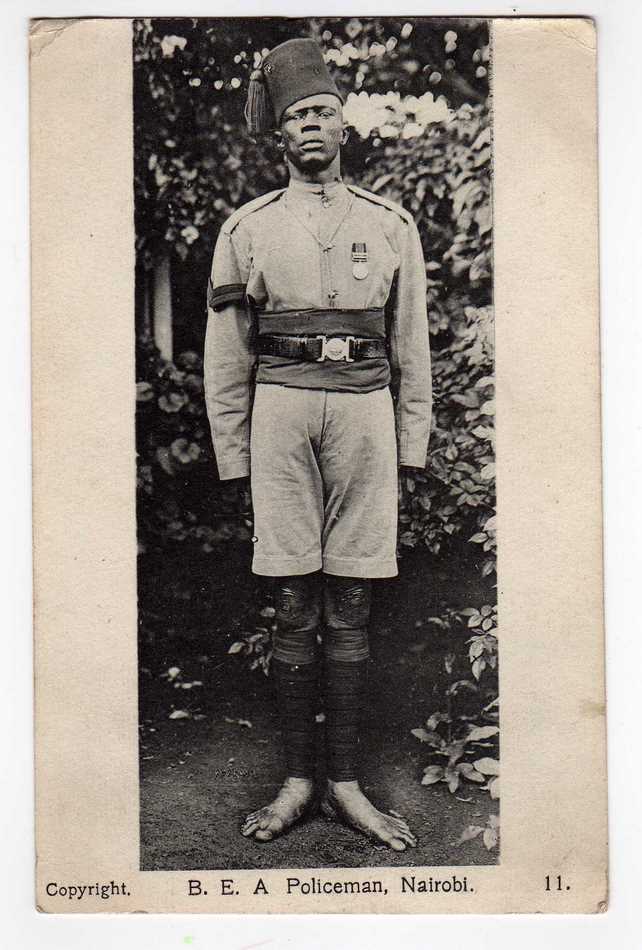 THE EAST AFRICA POLICE SERVICE BATTALION
THE EAST AFRICA POLICE SERVICE BATTALION
During the initial months of the Great War Uganda and British East Africa (BEA) both formed Police Service Battalions and so quickly produced more combat troops. Whilst the Ugandan Police Battalion was immediately deployed to counter the military threat along the German East Africa border, BEA had to also counter security problems in the northern regions of Turkanaland, Jubaland and along the Abyssinian border.
Normally the King's African Rifles (KAR) was deployed on northern frontier security duties. However, until Indian Army troops arrived, the KAR was needed to counter German Schutztruppe demolition patrols that were targeting the Uganda Railway line and infiltrating across the border from Lake Victoria down to Mombasa.
The BEA Police selected 400 Askari for the Police Service Battalion plus twelve European officers and two Warrant Officers. The Commanding Officer was Brevet Major W.F.S. Edwards, DSO, Inspector General of the East Africa and Uganda Police.
The Battalion went under canvas in the Nairobi Police Depot and commenced training on 1st December 1914. Four companies, each of around 75 Askari, were formed.
Major Edwards worked his men hard hoping to be deployed against the German threat, but on 11th January 1915 he was ordered to move his Battalion north to deal with Turkana raiders. 3,000 porters were used to carry stores and equipment into the operational area near Lake Rudolf. The Turkana were herdsmen who, along with their tribal neighbours, raided cattle in a never-ending cycle of raid and counter-raid. Turkana warriors rarely fought in formation, but ferociously picked off enemy stragglers or covertly tunneled under enemy thorn-tree cattle enclosures, called zaribas, to make surprise attacks on sentries. Turkana weapons were double-ended "sword spears" about 6 feet long, and for close-combat circular wrist-knives for disemboweling and curved finger-knives for eye-gouging were used.
Firepower proved decisive, and in a series of small engagements during which Sudanese troops assisted from the north and Ugandan police joined in from the west, the BEA Police Service Battalion subdued the Turkana raiders, capturing over 150,000 head of cattle, camels, donkeys, goats and sheep. Much of this stock was returned during the negotiations that followed the end of the fighting. The Battalion returned to Nairobi to rest and refit in June 1915, the East Africa General Service Medal with Bar "East Africa 1915" being awarded to all ranks who had served in Tukanaland. Major Edwards was Mentioned in Despatches and promoted to Brevet Lieutenant-Colonel.
Two Askari were awarded the African Distinguished Conduct Medal for Turkanaland operations, and their citations ( LG 4 May 17) give an indication of their operational duties:
1941 Sgt Mohamed Ahmed ? "For gallant conduct when he succeeded, while in charge of a party of 6 men, in capturing large quantities of stock in spite of repeated and determined efforts of large numbers of the enemy to recover the same."
3444 3/Constable Ndone Nzamba ? "For conspicuous gallantry during an enemy attack. Though severely wounded he took the place of his Section Commander who was wounded and continued to direct the fire of the section until the retirement of the enemy."In early August 1915 the Battalion moved into southern Uganda and northwestern GEA to take over positions on the Kagera River Line, Lt Col Edwards becoming OC of this sector. Here the BEA Police Askari frequently swam or silently canoed across the Kagera to raid Schutztruppe posts or burn down vegetation that provided cover for enemy patrols. Lt Col Edwards was now appointed Inspector General of Lines of Communication in East Africa, with the rank of Brigadier General. Captain W. Rigby became CO of the Battalion and was promoted to Major.
March 1916 saw the East Africa Police Service Battalion move from the Kagera River up through BEA to Northern Frontier Province where the Aulihan section of the Somalis was a threat. The Aulihan had over-run the Jubaland Armed Constabulary post at Serenli, killing 65 Askari and the British Post Commander, Lt F. Elliot. The Aulihan had seized all the arms and ammunition in the post including a Maxim gun.
The Battalion made a 450 mile march from the Thika railhead near Nairobi into the operational area and re-occupied Wajir Fort, which the District Commissioner had been ordered to evacuate after the Serenli disaster. On this march locally-hired camels were used to transport supplies.
Patrols went out searching for the Aulihan and their stock but were unsuccessful as the Somalis crossed the Abyssinian border whenever they felt threatened. In September 1916 the Battalion was ordered to leave one company at Wajir and to return to Nairobi, where it was disbanded at the end of the year, most of the Askari being returned to police duties. "D" Company, which had remained at Wajir was incorporated into a new KAR battalion, 5th KAR, that had been re-formed on 1st June 1916 for service in Jubaland and along BEA's Abyssinian border.
In 1918 Brigadier Edwards commanded a column in Portuguese East Africa named "Edforce". He was hot on von Lettow's trail in October and he finally accepted the Schutztruppe surrender at Abercorn, Northern Rhodesia on 18 November 1918. After receiving Lettow's sword Brigadier Edwards returned it as a gesture of respect.
Major Rigby was Mentioned in Despatches and received a DSO. He then went to Europe to command a Service Battalion of the Durham Light Infantry until the Armistice.
Another interesting officer in the East Africa Police Service Battalion was Geoffrey Le Blanc Smith. As a Trooper in the East Africa Mounted Rifles he gained a DCM ("For gallant conduct on 3rd November, 1914, during the engagement at Longido (East Africa), when he assisted to carry a wounded comrade into cover, whilst subjected to a very severe close range rifle fire.") during the abortive Tanga diversionary attack.
Commissioned and appointed Adjutant and Quartermaster in the East Africa Police Service Battalion Geoffrey received a MC for the Turkana operation. He stayed on the Kagera Line as a staff officer when the Battalion went to Wajir and was recommended for a DSO, but this was reduced to a bar to his MC. He returned to Turkana as Supplies and Transport Officer attached to the KAR during the Northern Turkana Expedition 1918, for which he received a promotion to Brevet Major and the clasp "East Africa 1918" to his East Africa General Service Medal.
The East Africa Police Service Battalion was a hasty war-time creation, as many other local units were, but it served its purpose and pulled its weight operationally. The decision to raise it was justified.0 -
May I offer this quote from "German Schutztruppe in East Africa 1889-1911" by Colonel Ernst Nigmann (The Battery Press, 2005, ISBN: 0-89839-335-3) Pages 2 to 5:
"The highly experienced Imperial Commissioner found a brilliant solution when he enlisted Sudanese.
These men had served in the Egyptian Army and had proven themselves to be splendid soldiers, especially during the fighting within the Sudan. But once the English had lost the Egyptian Sudan, they disbanded a number of Egyptian regiments which were now too expensive.
Soldiers from those units found themselves wandering across the countryside with no food, and generally in miserable circumstances. These people were an obvious backbone for the formation of the new unit. They eagerly responded to the call of German recruiters, who saved them from their deplorable fate and restored them to their customary trade under arms.
Wissman sent an Arabic-speaking officer, Lieutenant Theremin, ahead to Cairo to recruit the Sudanese. When Wissman arrived there in March (1889), accompanied by Medical Officer Schmelzkopf and by Bumiller, who later served him as adjutant, Theremin had already been very successful.
The recruits included not only Sudanese who had served as enlisted personnel, but also former officers and senior NCOs. A number of Turkish police had also been permitted to enlist, as they were extremely well qualified for police service. Some of the former Egyptian officers were soon found to be quite unsuitable and had to be discharged.
With the permission of the English government, the enlisted recruits were transported to a camp in Aden under the command of German officers and NCOs, although as yet without uniforms or weapons. This camp was very colorful: the Sudanese had all stipulated that their families should come with them, and many of them, concerned that they may not find a suitable spouse in a foreign land, had quickly selected a wife from among the daughters of their homeland.
After landing from the steamer Martha on 3 May 1889, the new unit was deployed on the African shore. Only one company was allocated to Dar Es-Salaam, while the main force was concentrated at Bagamoyo, which had been abandoned by the natives after being shelled by German warships. The troops were quartered in suitable stone houses in Bagamoyo.
The unit was organized as:
WHITES
25 Officers (1 Commander, 8 Company Commanders, 13 Lieutenants, 2 Doctors, 1 Paymaster)
7 Warrant Officers
56 NCOs including Corpsmen
BLACKS
6 Companies of Sudanese of about 100 men each
1 Company of Zulus of 100 men
1 Detachment of Askari (Local natives, about 80 men transferred from the German East Africa Company)
1 Detachment of Artillery (Sudanese, about 30 men)
1 Detachment of Seamen (Somali, about 40 men)
SPECIAL (Police Service)
2 Officers and 20 men (Turks)"
Harry
1 -
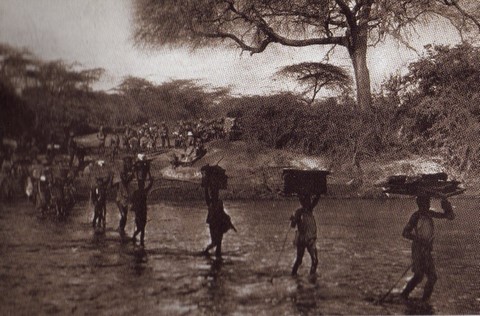
King's African Rifles transport.
Porters cross a river.
1 -
-
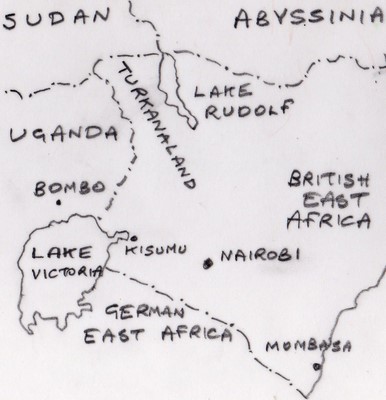 FORGOTTEN EDGES OF EMPIREMarched over by men of the The Royal Lancaster RegimentCompiled by Major Harry Fecitt MBE TDNumber 4 TURKANALAND
FORGOTTEN EDGES OF EMPIREMarched over by men of the The Royal Lancaster RegimentCompiled by Major Harry Fecitt MBE TDNumber 4 TURKANALANDThe Turkana tribe inhabited (and still do inhabit) the arid and desolate northern border region of British East Africa (now Kenya) west of Lake Rudolph. The Turkanas were a very warlike tribe, constantly fighting their neighbours in order to acquire livestock to replace their own losses caused by drought. The tribe was one of the last in the region to be "subdued" by colonial authorities.
The Turkanas fought with their traditional weapons ? long spears, narrow shields and vicious wrist-knives (circles of metal sharpened on the outer edge and worn around the wrist) that were used to disembowel opponents. They lived in a hot climate and had little use for clothing.
Turkana tactics were based around a traditional tribal saying that success in war is based not on power but on knowledge. Also they wished to avoid heavy casualties as the tribe did not have reserves of manpower. Thus the Turkanas would not mount a mass charge but preferred to blend into their landscape, appearing suddenly and fleetingly to spear enemy sentries or stragglers or run off cattle. These skilful and fearless fighters fiercely resisted any foreign penetration into their territory but they lacked central and effective military leadership.
Abyssinian gun-runners traded with the tribesmen, offering firearms for ivory. The Abyssinians also encouraged the Turkana to resist the growing authority of the British colonial government. Sometimes Abyssinian troops or irregulars would cross the border to fight alongside the Turkana. However the tribe never really trusted the Abyssinians, and the firearms were poorly and ineffectively handled due to a failure to comprehend the weapons' capabilities.
In 1910 the police in eastern Uganda were responsible for maintaining law and order in Karamoja, a tribal area just west of Turkanaland, but were short of men and so could not go to investigate reports of fighting between the Karamojong and Turkana tribes. 4th King's African Rifles (4 KAR), the Uganda battalion, was tasked with escorting a Political Officer into Karamoja, helping him determine the facts, and disarming and punishing recalcitrants as the Political Officer decided. This expedition became known as the Turkana Mission 1910-11. Although hardly any fighting took place this mission is a good example of the type of policing action that colonial military units were involved in at that time.
Lieutenant Edward Gerald Mytton Thorneycroft, Royal Lancaster Regiment, was one of the three KAR officers on the mission, which also contained a Doctor, 103 African Askari and a Maxim gun detachment. Because the route from north-eastern Uganda into Turkanaland was not proven the mission, starting out on 21st November 1910, crossed Lake Victoria from Uganda in a steamer to Kisumu in British East Africa, then took a train to Nakuru and then commenced marching north.
The main problems were logistic ones. Ox-waggons were hired at Nakuru and over 450 porters were also required to carry supplies for the mission. On arrival at Lake Baringo the ox-waggons went home as the owners would not risk them going any further north. The Assistant Distict Commissioner at Baringo arranged for the hire of over 100 donkeys to replace the ox-waggons and the Askari were detailed to improvise panniers for the donkey loads using old sacking, as the bags of food had to be protected from the dense thorn trees that lay ahead. Meanwhile Edward Thorneycroft and his fellow officers went out shooting game to provide ration-meat and also skins for sandals.
A difficult fly-belt (terrain dominated by tsetse-fly where horses and game cannot survive, but where donkeys sometimes can) lay ahead and the mission used the porters to cross it. But the porters were collapsing with dysentery and the mission was glad to reach the Kerio River where tribesmen offered bullocks and sheep for sale. The mission then pushed on to the Turkwell River through herds of elephant and rhino that on one occasion stampeded the donkey column, and finally reached Turkwell Boma.
Here on 4th February 1911 Edward Thorneycroft took over command of the military personnel in the mission. His Askari escorted the Political Officer around the region to talk to the tribes and impose fines of livestock if raiding had occurred. The prevailing attitude of the various tribesmen was not to argue but just to say that raiding was part of their way of life. In one judgement the Political Officer decided that the Turkana had been raided against by the Karamoja. The Karamoja were reluctant to accept their fine and so Lt Thorneycroft and his men pursued the fleeing Karamoja herds, overtook them and captured 800 head, 200 of which were handed back to a delighted Turkana delegation to compensate for Turkana losses.
After a month or so of these duties the mission was terminated and Edward Thorneycroft marched back to Bombo, Uganda with his men, having covered 780 miles on foot. In September 1911 Edward Thorneycroft was promoted to Captain and appointed Adjutant of 4KAR. He was killed in action three years later whilst fighting a German incursion into British East Africa.
Raiding continued in and around Turkanaland whilst the Governors of Uganda and British East Africa debated who should be responsible for this area. A large military expedition was planned for 1914 but the Great War intervened. 4 KAR was fully committed on the southern border with German East Africa and British Sudanese forces moved into northern Uganda to temporarily assume responsibility for security. Lawlessness increased over the next four years as British garrisons in the area remained under-manned and resulted in a large security operation mounted from both Sudan and British East Africa from April to June 1918. This became known as the Turkana Patrol.
But this failed to suppress raiding as the Abyssinian gun-runners maintained their activities, and the area where Sudan, Abyssinia and British East Africa met provided easy escape routes for fleeing raiders. Even today the tribes in this remote region (where the killings took place in the book and film "The Constant Gardner") raid each other's herds and sometimes violate and kill each other's women and children - and now they have the use of automatic weapons because the gun-runners still thrive.
1 -
If you do a search on "Great War Forum" you should find an archive website from where you can download the last version of regiments.org.
0 -
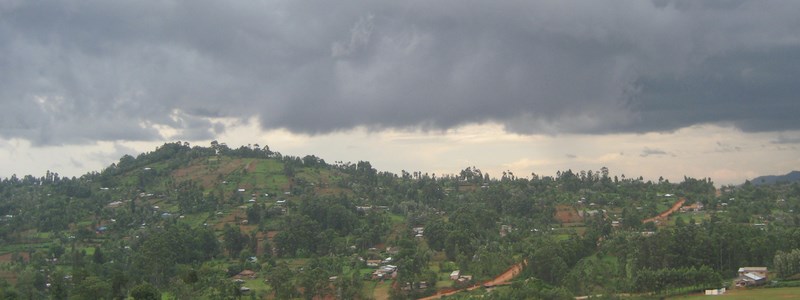
The southern outskirts of Kisii on a wet day
1 -
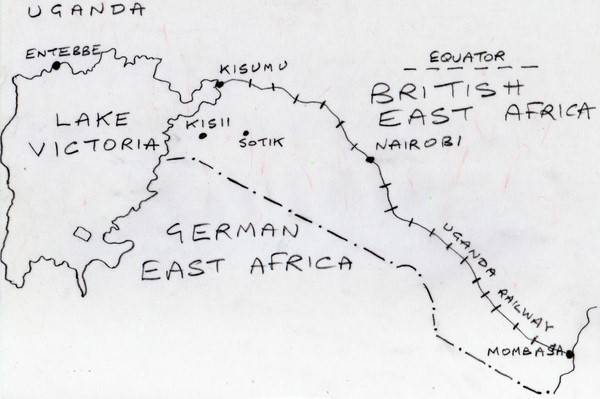
Map showing Kisii, the centre of Gusiiland
FORGOTTEN EDGES OF EMPIREMarched over by men of the The Royal Lancaster RegimentIntroducing some little-known campaigns where men of the King's Own served.Compiled by Major Harry Fecitt MBE TDNumber 3GUSIILANDGusiiland lay on the southwestern highlands of British East Africa (now named Kenya) about 50 miles south and southeast of Kisumu, where the British-built railway from Mombasa named the Uganda Railway terminated. From Kisumu passengers and goods were transported in steamers across the lake to Uganda.Gusiiland was extremely fertile, attracting rainfall throughout the year. The local tribes, named the Gusii, grew a variety of crops and herded cattle. The Gusii lived in clans but lacked a central organization to determine tribal policies, and this led to them rarely uniting as a whole tribe. They were extremely superstitious and prophets and tribal doctors ("witch doctors") exercised a lot of knowledge and influence. This knowledge could be very practical and useful as in the case of trepanning, where the doctors drilled a hole in the skull to relieve headaches or mental illness.
Since 1894 Gusiiland had been theoretically administered by the British as part of the Uganda Protectorate but in 1905 it was transferred with other eastern Uganda territory to be part of British East Africa. However the British had only concerned themselves with the fringes of Gusiiland and knew little about the heartland. It was only when a minor Gusii clan living on the northern Gusiiland border towards Lake Victoria came to Kisumu to request British protection from stronger Gusii clans who kept raiding and stealing cattle, that the British decided to enter Gusii territory. Action needed to be taken because the Gusii were also regularly raiding the Luo tribe who inhabited the southern shore of Lake Victoria. The British administrators also had in mind that Gusiiland could be a potential area for European settlement.
In June 1905 a British column subdued the Sotik tribe who were the Gusii's eastern neighbours and who had recently raided cattle from the Masai and taken captives. As a punishment 5,000 head of cattle were taken from the Sotik. This success led to an expedition against the Gusii four months later. A 100-man strong company of the King's African Rifles and 50 policemen marched from Kericho southwest into Gusiiland to punish the tribe for murdering Luos near Lake Victoria. The Gusii that had collected to fight were armed with long-shafted spears with small heads and on 28th September they charged right up to the KAR bayonets before the Askari firepower killed 67 of them. On 4th October around 600 Gusii attacked the British column again, and although the Askari were ordered to initially fire over the attackers' heads about 30 Gusii were killed and the same number wounded. The Gusii now realized that the rifles that the Askari carried were not sticks but were firearms that could kill at a distance.
The British column stayed two weeks in Gusiiland collecting many cattle as a reprisal and having to fight several skirmishes whilst doing so. This led to more deaths of Gusii warriors. (The KAR Askari enjoyed rounding-up livestock as, when out of sight of their officers, they rounded-up the shepherdesses as well.) The British column then marched away to other duties leaving a legacy of ill feeling. Due to staff shortages the British administration was slow to follow-up the military action and it was not until early 1907 that a government station was sited at a location named Kisii. G.A.S. Northcote (an Oxford graduate who joined the Colonial Service in 1904 and eventually rose to be Governor of Hong Kong) was appointed Assistant District Commissioner at Kisii. He was an enlightened man but had difficulties in persuading all sections of the Gusii (now re-named the Wakissi by the British) to accept British rule and law. The clans who had suffered during the 1905 punitive expedition were especially recalcitrant ? they had not invited the British to their territory and they did not want the British to remain.
Northcote introduced the British principle of taxation to be paid in cash. To a cashless society this presented problems and led to an influx of Swahili (coastal) cattle dealers and Asian and European traders who would buy livestock and other commodities from the Gusii, but not always fairly. This further displeased the conservative elements amongst the Gusii, particularly the prophets and tribal doctors. Also as he constructed his government station Northcote sometimes could not always hire the labour or buy the materials that he needed. In those situations he used force to procure the labour and materials, and although the debts were always settled later in cash, Gusii society was further alienated.
On 30th May 1907 Lieutenants John Bois and Thomas O. Fitzgerald were seconded from The Royal Lancaster Regiment to The 3rd King's African Rifles based in British East Africa. Towards the end of 1907 John Bois, serving in No 1 Company 3 KAR, took out a patrol of 35 rifles into the Western Highlands to quell disturbances. (Lieutenant Bois, who had gained the Queen's Medal with four clasps in the South African War was later awarded the African General Service Medal with clasp inscribed "Somaliland 1908-10" for operations described in the first article of this series.)
In Kisii in November 1907 a famous Gusii prophetess called Muraa was inflaming opinion against Northcote and the British presence that he represented. Northcote arrested Muraa for a minor offence and later released her. He then held a large tribal baraza (public discussion) during which he hoped to clear the air. It was not to be. On 11th January 1908 Northcote was investigating the theft of cash from Swahili traders when the thief, inflamed by taunts from Muraa, speared Northcote in the back, narrowly missing his spine. The wound was painful but not critical, and to Northcote and other Europeans working with the tribes this type of incident was to be expected as part of the job, as the spearing was recognized as being a personal issue rather than a tribal one.
However to the rear echelon back in Nairobi the spearing represented a major challenge to British authority that had to be punished. Groups of Gusii warriors now further enraged the British administration by attacking and killing two unarmed policemen and an Asian trader and by reverting to the old pastime of raiding Luo territory. Many warriors approached Kisii hoping to finish off Northcote and the traders, but a display of rifles kept the spearmen at bay. As usual the Gusii did not unite as a tribe and only the clans that really disliked the British took up their spears.
A British punitive expedition was organized and dispatched by train to Kisumu. From there 334 officers and men from the King's African Rifles, equipped with Maxim guns and supported by 50 Nandi tribal auxiliaries sailed by steamer to Kendu Bay, 53 armed police having gone ahead to Kisii. (The Nandi were a tribe living to the northeast of Kisumu that had fiercely resisted the construction of the Uganda Railway through its territory, but whose warriors later fought well for the British as irregulars.) Marching south into Gusiiland for a month the British force seized cattle, burned huts and used their rifles and machine-guns to kill anyone who stood in their way. There were no pitched battles and no British casualties but 240 Gusii were killed (like many body counts of the day this did not include the wounded men, women and children who took refuge in the bush until they died) and 7,000 head of cattle and 5,000 sheep and goats were seized.
In Nairobi the severity meted out to the Gussi was felt to be justified as it was followed by the swift imposition of British administrative procedures throughout Gusiiland. But Northcote thought that the whole operation was too severe and was poorly carried out by the KAR. In a later letter to his father he wrote: "It would take too long to describe the absolute idiocy, obstinacy and want of knowledge of military operations in this country that they shewed."
Captain T.O. FitzGerald wrote in a jingoistic style: "In January, 1908, the Kisii became out of hand and speared the District Commissioner when travelling round his district as a protest, against paying taxes. This necessitated an expedition being sent to punish the tribe. It was alleged that the Wakissi were a very ferocious and formidable tribe, so great excitement prevailed among the officers chosen to take part in this expedition, as it was thought that it would be a really good show. However the formidable enemy turned out to be a myth, the warriors having no stomach for a fight. Large numbers of cattle were captured and many huts destroyed besides about 150 casualties inflicted on the tribe.
After about six weeks the expedition returned to Nairobi from what was humorously described as the Six Weeks' War. Anyway whatever jibes may have been made against this expedition it is significant that the Kisii have given no further trouble since and the result bears out the contention that if a tribe has got to be punished heavy punishment in the first instance minimizes trouble later."
But Captain FitzGerald was not quite correct. Six years later a battle at Kisii would result in the death of another officer from The Royal Lancaster Regiment, and give the Gusii people a chance to again vent their anger against British colonial rule.
1 -
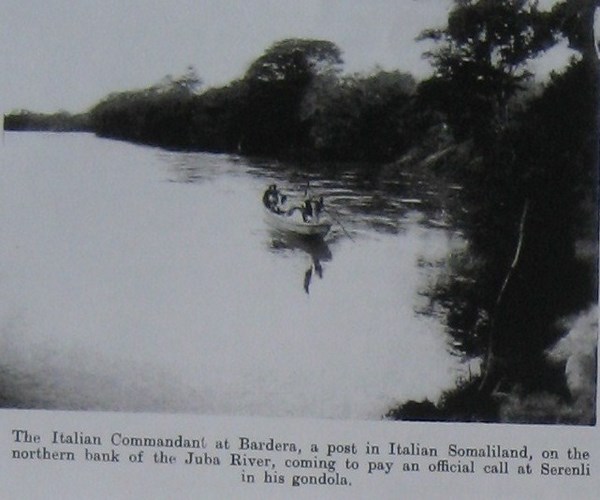
Serenli on the Juba River
1 -
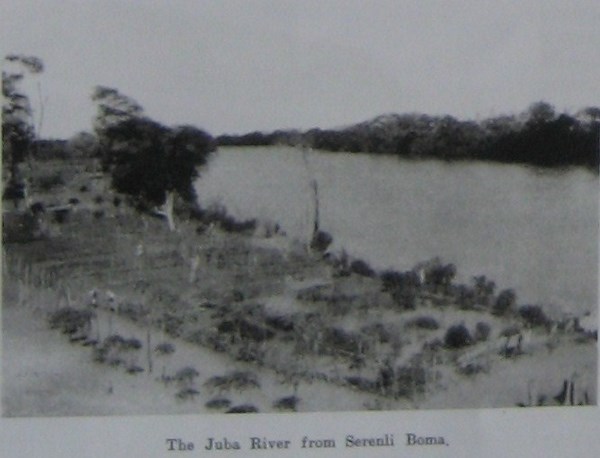
Juba River from Serenli Boma
1 -

Map showing Jubaland
FORGOTTEN EDGES OF EMPIREMarched over by men of the The Royal Lancaster RegimentIntroducing some little-known campaigns where men of the King's Own served.Compiled by Major Harry Fecitt MBE TDNumber 2JUBALANDJubaland was a generally dry and arid country covered by bushes which lay in the northeast of British East Africa (now named Kenya). The main physical feature was the Juba River which ran south into the Indian Ocean near Kismayu. The Juba River formed the boundary between British East Africa to the west and Italian Somaliland (now named Somalia) to the east. A few lakes and swamps occurred where the river overflowed its banks. Kismayu, located in British territory 12 miles southwest of the River Juba's mouth, had an all-weather harbour. The river mouth was closed by a sandbar with a depth of only one fathom at high water, but once the bar was crossed shallow-draught steamers enjoyed a fine navigable waterway up to rapids at Bardera, 150 miles from the sea.
The Imperial British East Africa Company, a commercial association founded to develop African trade in the area, began administering Jubaland in 1891 from a base at Kismayu. On 1st July 1895 the British Foreign Office took over the company's administrative responsibilities.
The hinterland was sparsely populated by fiercely independent Somali tribes who made nomadic migrations with their flocks between water sources. The tribes regularly raided each other . When the King's African Rifles arrived as British garrison troops the tribes accepted these intruders because of their firepower, but attempts at taxation by the British were fiercely resisted. Whenever any fighting took place the tactics of both sides were planned around securing and holding water supplies.
In June 1910 the British established a defensive post at Serenli, four miles north of Bardera. The local Marehan tribe was truculent and had to be treated as a threat, so the post was built on a small hill overlooking the river. An outer zareba (a perimeter hedge constructed from thorny bushes and branches) with machine-gun emplacements built into it surrounded the post. An inner fortification of barbed wire and breastworks enclosed the living and storage areas. All the bush around the post was cut down to provide good fields of fire. The proximity to Bardera, which lay on the Italian side of the river, was not accidental as the Italian military maintained a regional HQ at Bardera. The traders in Bardera were very helpful to the British troops across the river, often selling them food and goods when the British resupply system failed.
A small steamer re-supplied the Serenli base during the latter six months of each year when the river contained sufficient water. It took between 14 and 20 days to move up-river to Serenli from a post established at Gobwen near the river mouth, but when travelling downstream the time was halved. In May 1911 Captain T.O. FitzGerald, The Royal Lancaster Regiment, was sent to command the garrison at Serenli with troops from 3 King's African Rifles.
Captain FitzGerald wrote: "It is a very pleasant, if somewhat slow, journey up the Juba River. Owing to the number of snags in the river bed the steamer ties up to the bank every evening, when it is possible to get some very good duck shooting before nightfall. The river is infested with crocodiles, and during a fourteen days' journey up the river the writer and another officer shot 78 of these rapacious brutes. It is a wonderful sight to see hundreds of these reptiles lying on the sand banks basking in the sun and when disturbed by the crack of a rifle to watch them scuttle away into the water. It is significant to note that the natives when drawing water from the river do so with cup-shaped gourds, tied to the end of a long pole. Many of these natives have been taken by crocodiles when bailing out water, by hand, from the river. It is quite a common thing for a crocodile to seize a camel by the nose when drinking water and pull it into the river, where it is soon torn to pieces by these ravenous creatures. To give some idea of the variety of food these beasts indulge in; the contents of the stomach of one that had been shot was as follows : an askari's blue jersey and puttees, various trinkets worn round the necks of native women, and an undigested leg bone of an ox, with various other bits and pieces."
At Serenli Captain Fitzgerald commanded two British Officers, two Native Officers and 121 Askari (African soldiers). For a time he also held the post of Acting District Commissioner. However the major threat that developed against Captain FitzGerald's force was not the local Marehan tribesmen but sickness. In late 1911 and early 1912 a serious epidemic of beri-beri broke out amongst the Sudanese Askari (3 KAR recruited Sudanese soldiers whenever possible, but this race was said to be very susceptible to beri-beri) and their families at Serenli. Of 87 Askari, 25 women and two "followers" (civilians working for the military) affected, 41 Askari and three women died. This was a severe blow to the garrison strength. At that time the only means of communication out of Serenli was by runner to Gobwen, 150 miles away, and so it took fifteen days before a doctor arrived to treat the sick.
The Medical Board of Inquiry that followed this incident determined that the causes of the disease were an inferior type of rice supplied that was deficient in mineral salts, the lack of green vegetables, which were unobtainable in Serenli, the general lack of variety in diet, the exceptionally hot climate of the station and the fact that the troops spent too long in a static location. (The Inspector-General of the King's African Rifles had recently passed through Serenli and his later report observed that static posts served no useful purpose, and that more camels were needed to make the Askari mobile and capable of accompanying civil officers on their visits to the tribes.) However the Medical Board of Inquiry paid a warm tribute to the way in which Captain FitzGerald handled a very trying situation.
Another administrative problem for Captain Fitzgerald was provided by the accountants back at Nairobi HQ. The Askari at Serenli could select to be paid in "americani" cloth (bolts of material for clothing and general use), Indian Rupees (the currency of British East Africa) or Thalers (Austrian Maria Theresa Dollars). The men's pay accounts had to be kept in so many yards of "americani", rupees or dollars.
Captain FitzGerald wrote: ". . . and as the value of the latter (Thalers) fluctuated considerably the Treasurer in Nairobi, who received the accounts about three months later, usually got frightfully perturbed and demanded an explanation as to why Mohamed Ferjalla was paid dollars at the rate of two shillings and sixpence when the value was only two shillings. The obvious reply was that one was not in touch with the money market by telephone or wireless and it was impossible to get the latest quotation."
In July 1912 Captain Fitzgerald's Askari were relieved at Serenli and they returned to Nairobi. For superstitious reasons "C" Company 3 KAR, which had lost the beri-beri victims, was disbanded and its men posted to "B" Company. "C" Company was not reformed. Between December 1913 and May 1914 a large operation named the Marehan Patrol was mounted against the Marehan tribe in Jubaland. Companies from 1 KAR (from Nyasaland, now named Malawi), 3 KAR and 4 KAR (from Uganda) took part but there was no decisive outcome. The Marehan took advantage of weak British garrisons in Jubaland during the Great War to overrun and capture Serenli in 1916, killing the British garrison commander and 35 of his Askari. A punitive expedition between July 1917 and March 1918 recaptured Serenli, tracked down the Marehan responsible for the British deaths in 1916 and hanged eight of the leading perpetrators. Over 4,200 Marehan camels and goats were captured and slaughtered as a reprisal against the malcontents in the tribe.
In July 1925 Jubaland ceased to exist when the districts of Juba River and Kismayu (a total of 33,000 square miles) were ceded by Britain to Italy to become part of Italian Somaliland.
1 -
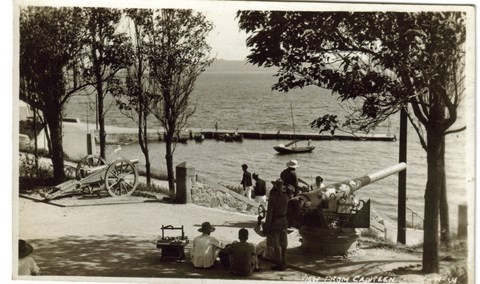
The Waterfront Wei-Hai-Wei.
(Note the policeman at the rear of the near gun.)
0 -
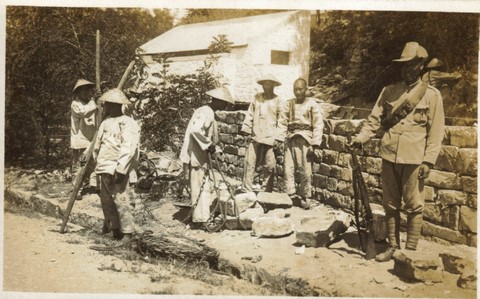
A Chinese policeman in British-administered Wei-Hai-Wei
The city of Weihai was part of a territory called "Weihaiwei", which was leased by the UK from 1898 until 1930. It lay on the north Chinese coast west of Seoul in Korea. It was a summer station for the naval China Station along with Hong Kong. Wei-Hai-Wei was rented from the Chinese government.
From 1898-99 it was administered by a Senior Naval Officer, RN; in 1899, this transferred to a military and civil commissioner appointed by the War Office. The garrison comprised some 200 British troops and a locally raised Chinese Regiment with British officers. In 1901, administration transferred to the Colonial Office. A Civil Commissioner was appointed to run the territory in 1902, and the Chinese Regiment was disbanded in 1903.
The Wei-Hai-Wei Regiment had been raised by the British and had performed well during the Boxer Rebellion. After disbandment in 1903 ex-members of the regiment were selected to join the Wei-Hai-Wei Police. An armed policeman is shown in the postcard above.
The territory became especially important to the British during the Great War when it was used as the Recruiting Centre and Depot for the Chinese Labour Corps. Companies of between 300 and 500 men were despatched to France via Vancouver, Halifax and Liverpool. Officers were recruited from Europeans working in China.
0 -
THE BAROTSE NATIVE POLICE
In 1899 Britain agreed to protect Barotseland, now located in western Zambia, and in 1901 the British High Commissioner at the Cape, Alfred Milner, proclaimed the formation of the Barotse Native Police, authorizing its strength at 300 African Rank and File led by white officers and NCOs from the British South Africa Police.
The Ruler of Barotseland, the Litunga, was not too keen on the idea but he was talked into accepting it. At that time the westernmost parts of his territory were being ravaged by slavers operating out of Portuguese West Africa (now Angola).
(A future Boundary Commission was to award most of these areas to Portugal.)
By 1902 240 men had been recruited and trained and allocated between five districts.
In his report for 1902 the British Resident, Major R.T. Coryngdon BSAP, commented:
?The corps is recruited chiefly from the Batoka natives, who take to the routine and discipline at once and who will make smart and reliable soldiers; a few Mashukulumbwe who contrary to expectations are amenable and obedient; and a few Barotse, who, though more intelligent, do not seem to take to the military life at all.
Experience has shown that it is always advisable to police a country with, if possible, natives from an alien tribe; . . .?
In the Rhodesias, unlike in British West and East Africa and Nyasaland, there were no regular native military units and so the Police were regarded as a military force.
The force was armed with rifles and two Maxims complete with pack saddles and tripods.
A suggestion to recruit 25 Sikhs to be employed as NCOs instead of the whites was accepted but never adopted as the African NCOs quickly proved themselves capable of commanding small detachments and patrols.
Whilst the Barotse Native Police did not have to fight any major engagements it carried out its duties professionally, maintaining the authority of Lewanika the Litunga, whilst also representing British interests in the region.
In 1905 the force now totaled 300 African Rank and File and eleven white officers, and was inspected by Lord Roberts at Victoria Falls.
A main operational task at that time was the prevention of the illicit traffic in rubber, arms and slaves across the Portuguese West Africa border.
In 1910 the force, now numbering 370 Africans, twelve white officers and six white NCOs, was inspected at Victoria Falls by His Royal Highness the Duke of Connaught.
He became Honorary Colonel-in Chief of the force, and, it is said, gave permission for the force to use the regimental march of the Royal Engineers: ?Wings?.
By now the duties of the force had been widened to include policing activities in the towns of Livingstone (now also known as Maramba), Broken Hill (now named Kabwe) and Ndola, just south of the Katanga border.
In 1912 the Barotse Native Police and the North-Eastern Rhodesia Constabulary were amalgamated into The Northern Rhodesia Police.
The unit was to fight hard and well during the Great War on the north-eastern border and in German East Africa.
Further reading:
?The History of The Northern Rhodesia Police? by Tim Wright. ISBN 0-9530174-4-3
?The Story of The Northern Rhodesia Regiment? by W.V. Brelsford.
?In Remotest Barotseland? by E.C. Harding
0 -
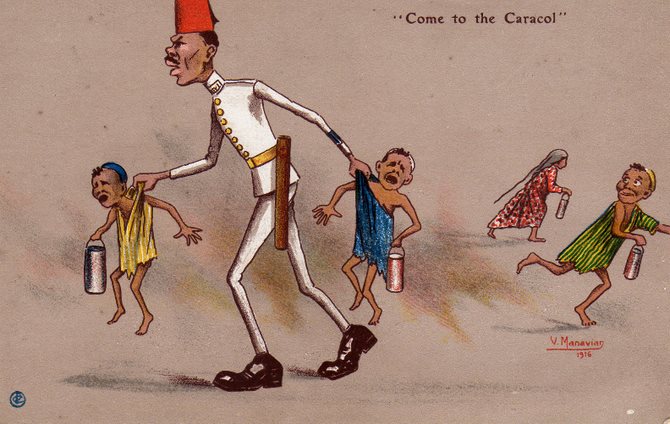
Endorsed on rear: "Egyptian Humour Serie 1 - No 8"
Some of the other cards in this series, showing British troops interfacing with local people, are politically incorrect for these modern times.
However to myself at least, they are indicative of social attitudes and behaviour during WW1 and are thus of historical interest.
0 -
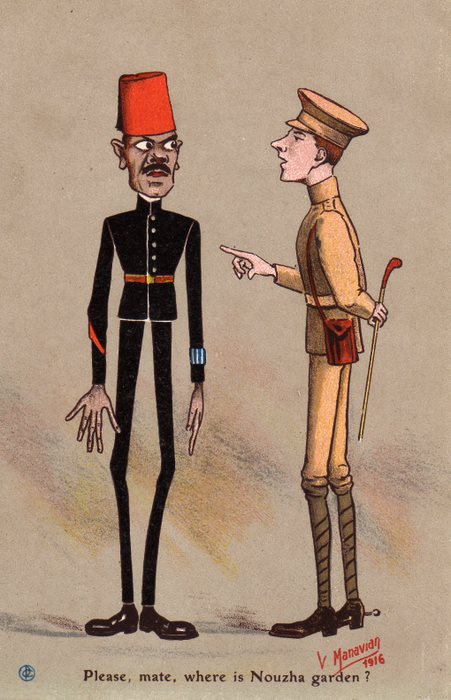
Endorsed on rear: "Egyptian Humour - Serie 1 - No 2"
Although Egypt doesn't qualify as "Commonwealth" these two cards fit into this topic.
They were part of Series drawn by V. Manavian and printed for sale to British troops.
0 -
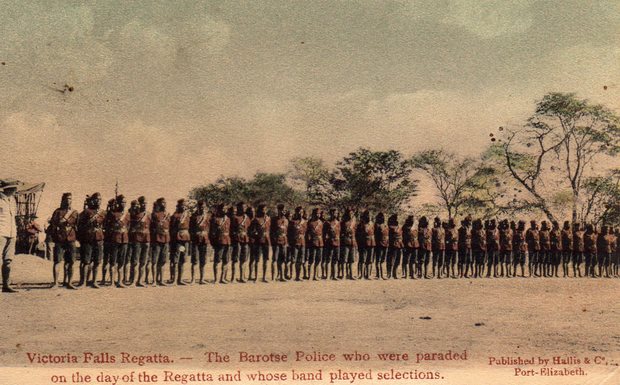
"Victoria Falls Regatta - The Barotse Police who were paraded on the day of the Regatta and whose band played selections."
Here is an interesting postcard.The postmark looks like 1910. The handwriting states: "These are the Police who will parade in front of the Duke of Connaught at Victoria Falls which I hope to visit. Cheap excursion from Cape Town 19 pounds 10 shillings."
0 -
Here's what I have written elsewhere (extracts from 3 postings):
Ross's ScoutsRoss's Scouts was a white mounted unit formed in British East Africa after the declaration of war.
Major Charles Joseph Ross DSO had been born in Australia in 1857. He ran away as a child to America where he lived with Indians, & then was a scout for the US Army in three Indian wars.
He then joined the Canadian North West Mounted Police for six years & was Chief Scout during the Riel Rebellion.
In the South African War he was awarded a DSO whilst riding with Roberts Horse & later comanded the Canadian Scouts.
He then stayed in Africa trading in Bukoba & buying land in GEA. He poached in the wilder parts of BEA & GEA, & when the German authorities seized his land in retaliation he moved to the Kisii region of BEA, continuing his activities & selling his ivory to an Asian trader in Shirati, just across the GEA border from Karonga.
Angry about the loss of his land Ross would sometimes raid across the GEA border to seize herds of native cattle, infuriating the German authorities.
To curtail these activities BEA appointed him an Assistant Game Ranger in 1907 & he gradually became respectable, guideing Theodore Rooseveldt's Smithsonian Institute Safari in 1909.
A year later he guided another Safari for "Buffalo" Jones, a famous USA wild-life conserver who wished to lassoo animals & photograph them rather than shoot them dead.
On this safari the photographer was Cherry Kearton who later served in East Africa in the 25th Royal Fusiliers before moving to photographic duties with flying units.
Charles Ross knew the bush on both sides of the border & he was a proven military leader.
On the declaration of war he was appointed to form his own unit of Scouts & in November 1914 the 40 men of Ross's Scouts were sent to secure the western end of the BEA-GEA border area.
Back on the ground he knew well Major Ross wasted no time in settling old scores.
He is believed to have sent the male organs from a slaughtered goat across the GEA border to his old adversary District Commissioner Schultz, along with a note explaining that this was what the DC could look forward to.
"E" Company 4 KAR established defended posts on the border south of Karungu & raided southwards into GEA with Ross. The opposition was minimal as the Schutztruppe (weak detachments of 7 FK & 14 FK) were south of the Mara River.
Probably now things started to get out of hand, Ross's Scouts were a rough bunch of lads even by African frontier standards, & the looting & killing may have been "over the top" to spectators in Nairobi.
Also, as was to happen elsewhere during the war, the temptation of seeing cash in the form of ivory ambling around the bush may not have been resisted.
On 28 November 1914 Ross & his men rode into Shirati to find the Germans gone, but he had to ride quickly out when a British steamer shelled the town (see Post #354).
However Ross & 4 KAR did not always win without loss. On 01 December a KAR & BEA Police patrol about 50 strong had a sharp fight at Susini during which the British lost BEA Police Lieutenant C.E.L. Bowen & two Askari.
This border area quietened down in December but flared up again in January 1915 resulting in a deployment of Loyal North Lancashires onto the Lake.
On 13 January 1914 General Stewart interviewed both Major C.R. Ross & Lieutenant Paysant of Ross's Scouts at Kisumu. As a result of these interviews it was decided to disband Ross's Scouts.
Ross's 40 men chose where next to go & some went on Intelligence duties. Lieutenant J.J. Drought & 18 other officers, NCOs & men were posted to the East African Mounted Rifles on 15 January. They stayed in the eastern Lake area & were known as "Drought's Troop", & they raised a force of tribesmen for cross-border patrolling known as the "Skin Corps" because of the tribesmens' aversion to using clothing.
On the disbandment of Ross's Scouts Charles Ross dropped out of sight.
The Official History states that he resigned his commission in December 1914, but his unit wasn't disbanded until mid-January 1915..
He qualified for the 1914/15 Star, & for the War & Victory medals & his medal card lists him as a Major in Ross's Scouts, East African Mounted Rifles & East African Signal Company.
The History of The East African Mounted Rifles does not list him as ever being on strength.
Neil Speed who wrote his biography "Born to Fight" (The Caps & Flints Press, Melbourne, 2002) believes that he may have joined his old pals Paddy Driscoll & Frederick Selous in 25th Royal Fusiliers (The Legion of Frontiersmen) & become involved in Intelligence duties. Certainly he was convalescing back in UK in 1917 when the remnants of 25th Royal Fusiliers also were.
After the war Ross re-joined the BEA Game Department, working from his home in Eldama Ravine, Rift Valley Province in what is now Kenya.
On 19 June 1922, just 15 days short of his 65th birthday, he died of double pneumonia caused by exposure after a fall whilst out on patrol.
Does anyone have any more information on Charles Ross's war service?
0 -
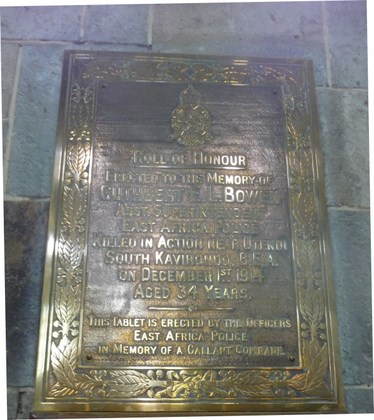
Cuthbert Bowen's memorial plaque in Nairobi Church of England Cathedral
0 -
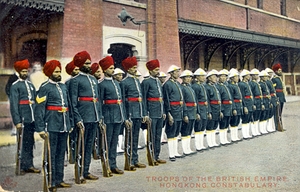
An interesting 1906 postcard of the Hong Kong Constabulary
 0
0 -
Gentlemen
PRIMROSE BACKING
The Curator of the QLR Museum, Ms Jane Davies, has kindly provided this extract from the QLR Handbook:
'The Primrose Diamond worn on our soldier's berets was introduced by Lt
Col FFE Allen DSC, CO of 1st Bn the ELANR (East Lancashire Regiment), at Hamburg in 1945.
Primrose was the facing colour of the 30th Ft 1702-1881 and was carried again
in 1916 when 1st Bn ELANR wore patches of that colour on their helmets
and sleeves at the battle of the Somme. The distinctive diamond shape
of the backing may be traced back to the old 59th, the 'Lilywhites',
who when in India in 1902-3 received permission to wear a white diamond
patch on their sun helmets. The backing is not worn by officers or by
warrent officers class I.'
Harry
ex-1 LOYALS and 4QLR
0 -

Lieutenant Cuthbert Bowen's grave in Kisumu Cemetery, Kenya
Lieutenant C.E.L. BOWEN, East African PoliceThe civilian European graves in Kisumu Cemetery are now suffering from neglect but the graves tended by the Commonwealth War Graves Commission are well maintained, and these include nine graves holding German remains that were brought in from Kisii Boma after the action there on 12th September 1914.
One interesting CWGC headstone at Kisumu commemorates Lieutenant C.E.L. Bowen of the East African Police who was killed in action on 1st December 1914, age 30 years. CWGC records list Lt Bowen as serving in the East African Corps of Military Police. "The Bond of Sacrifice", Volume 1, states that he was attached to the King's African Rifles at the time of his death.
Cuthbert Edward Latimer Bowen was the son of a Swansea vicar. He was educated at Rugby and he served in the South African War with the Queen's Royal West Surrey Regiment (Militia), joining the 1st Battalion of that Regiment at Peshawar on a Regular Commission in 1903. However in 1905 he left the Army to accept a Colonial Office post as an Assistant District Inspector of Police in British East Africa.
On the declaration of war Cuthbert Bowen was commissioned into the forces of the British East Africa Protectorate and was sent with a few policemen to operate on the German East African border southwest of Kisumu. In late November 1914 the British Forces in this area were "E" Company 4 KAR under Major R.F.B. Knox working out of defended camps at Suna and Butende, supported by Bowen's police detachment and Ross' Scouts. The latter unit had been recently raised by Major Charles Joseph Ross DSO, an East African hunter and adventurer who was working in the BEA Game Department, and consisted of around 40 mounted men known to Ross. Ross's Scouts had been in the Lake border area since the Kisii action, raiding south to Musoma and the Mara River and removing any cattle that they found back to BEA territory.
The German Schutztruppe forces in the area were No 7 and No 14 Field Companies based at Mwanza under Captain Bock von Wulfingham (whose photograph can be seen in the Arusha Boma Museum). These companies had deployed forward detachments in forts at Musoma, Utegi and Shirati, but pressure from the British had recently caused the Schutztruppe to evacuate Shirati. However German patrols remained near the border.
Lieutenant Bowen was working with "E" Company 4 KAR and during a patrol on late November he captured a German prisoner. News then came in of two more Germans with Askari on Susuni Hill, 25 miles southeast of Shirati. On 1st December Major Ross at Butende ordered Cuthbert Bowen and his police with half of "E" Company, a total of around 50 men, to attack this enemy detachment and hopefully take more prisoners.
On reaching the objective the British force split, a KAR officer taking his Askari on one route whilst Cuthbert Bowen made directly for the summit with his police. As the police approached the summit the Schutztruppe surprised them, killing Lieutenant Bowen and two policemen. The British force consolidated and fought with the Germans, forcing a Schutztruppe withdrawal as darkness fell. The following morning the three British dead were recovered and buried at the foot of Susuni Hill. Later Cuthbert Bowen's remains were re-buried in Kisumu Cemetery.
Ross' Scouts had become notorious and controversial by the end of 1914 and they were disbanded. Around 30 of them enlisted in the East African Mounted Rifles as a Scouts Troop under Lieutenant J.J. Drought and this troop remained in the Lake border area. Sporadic fighting continued in the region until the capture of Mwanza by British forces in July 1916. By then Drought was a Major commanding the East Lake Border Police.
 0
0


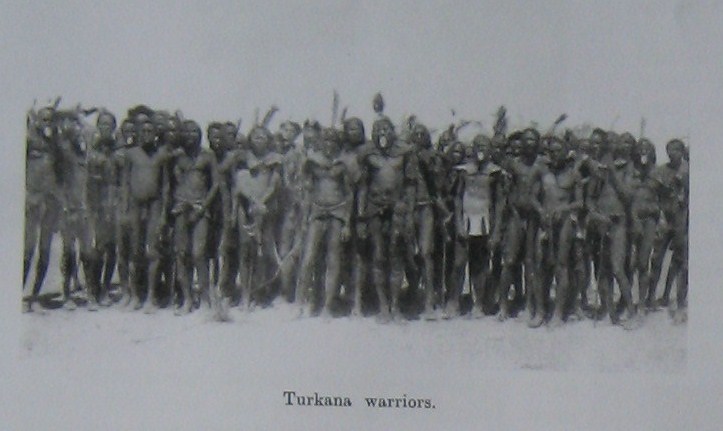
Identification help: Egyptian/ German East African Colonial Group
in Great Britain: Orders, Gallantry, Campaign Medals
Posted
Thanks to Per Finsted of Denmark who has just sent me a copy of this Richard Knotel plate we can see more uniform detail of the various components of the first German East African Force.
Harry